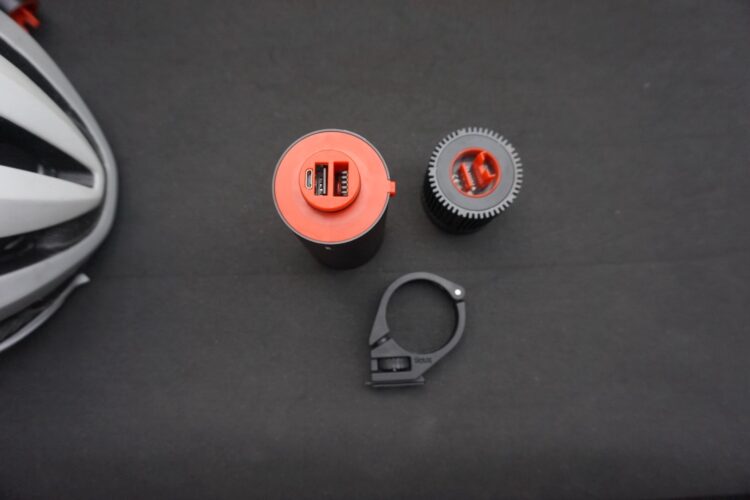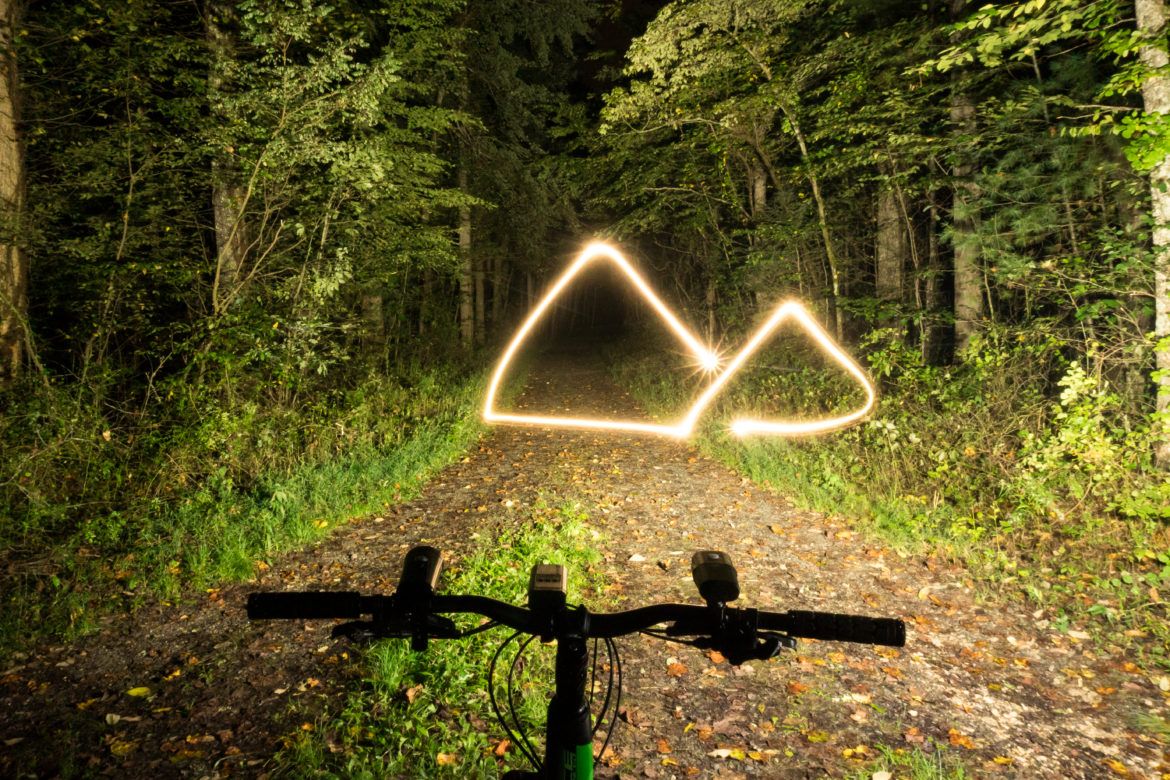
Fall is officially here, and it’s beginning to show. As the days grow shorter and it becomes more and more difficult to squeeze in a ride after work, you might want to consider embracing the dark (if you haven’t already). Night riding allows you to put in some miles whenever you can find time, and it’s a great way to mix up your typical ride if it’s starting to become a little stale.
Of course, the quality of your night riding experience will largely be dictated by the quality of your lights. While plenty of people scrape by with cheap Amazon lights, they come with downsides like suboptimal beam patterns, fewer mounting options, and unreliable quality. If that’s all the budget allows for, go for it. On the other hand, if you’ve got a little bit of breathing room in the bank account, these purpose-built mountain bike lights will open up a whole new world.
In this review, we’ll look at two different kinds of lights: all-in-one options that contain battery and light head in one package, and battery pack options where light head and power source are separate. We’ll address the pros and cons of each and have a look at some of the specific lights we tested, and then we’ll talk about which lights are best for your specific needs. Read on and have a look at some of the most advanced bike lights on the market.

All-in-one Options
Night riding can add an annoying level of complexity to your daily ride. Instead of hopping on your bike and pedaling off into the sunset, you spend extra time fiddling around in the dark with straps and Velcro, mounting light heads on helmets and handlebars, securing batteries on frames and in packs, and connecting the two together with extension cords that have just the right amount of slack. It’s worth it once you get going, but it adds unnecessary turnaround time to your ride.
Fortunately, if time is of the essence, a few all-in-one light models promise to streamline your night ride. With these units, the battery is built into the lamp head and you put it on your bike and go. That makes them heavier, meaning they’re typically handlebar mounted. While the three models I tested all have a strong light output, in a perfect world you’ll pair them with a helmet-mounted light to really illuminate the trail and ensure you can look ahead in corners or see the landing off drops.
Blackburn Countdown 1600


I found Blackburn’s Countdown 1600 close to perfect, and I’m willing to bet that most night riders will agree. Here are some of the key advantages:
- The tool-less mount features an easy-to-operate quick release to detach the light from the mount.
- The light is USB-rechargeable, which means you don’t have to keep track of a specific charger.
- Even if you don’t head out with a 100% charged light, the countdown timer shows you exactly how much time you have left on each power level.
- Pressing the power button alternates between whatever mode you pick and Blitz (full 1600 lumens). I liked Low/Blitz to extend battery life but it’s easy to switch it up.
The ONLY thing I didn’t like about this light (and I’m nitpicking here) is the small buttons. They don’t make it easy to adjust the light during technical stretches of trail, and in the colder seasons when days are shorter and night riding is most common, thicker gloves might exacerbate the issue.
That being said, the countdown timer is amazing. It’s nice to be able to head out with a light that’s been sitting in the garage for a while and know how much time you have to work with. Every other light I tested uses some variation of the flashing yellow/red light to indicate battery life. I guess that’s better than nothing, but when you’re going out into the woods by yourself, it’s nice to have something a little more specific.
Blackburn claims a battery life of 1:20 in Blitz mode, and after a complete charge the light told me I had 1:31 until empty. In reality it lasted 1:36, but there were never any noticeable leaps on the timer. It counted smoothly down, and when it showed 10 minutes remaining, it went dead after almost exactly 10 minutes. MSRP $170.
Light & Motion Taz 2000


The Taz 2000 is a good light, and if you’re looking for certain features it might be enough to justify the $90 price jump from the Countdown 1600. Beside the obvious 400 extra lumens (which is not very much to the eye), you’ll get:
- A 1:30 runtime on high (an extra 10 minutes over the Blackburn).
- Yellow side lights for commuting.
- A hook and loop rubber strap that makes it perfect for use on multiple bikes.
- A package that’s 24 grams lighter (in case you’re REALLY counting).
If you’re looking for all or most of these features, the Taz 2000 might be worth the money. Of course, you’re giving up one of the main selling points of the Blackburn model – the countdown timer. Since I only have one bike and I rarely ride on the road, I found myself reaching more consistently for the Countdown 1600. The Taz 2000 is also recharged via the micro-USB cables you probably have all over the place. MSRP $225.
Cateye Volt 1700
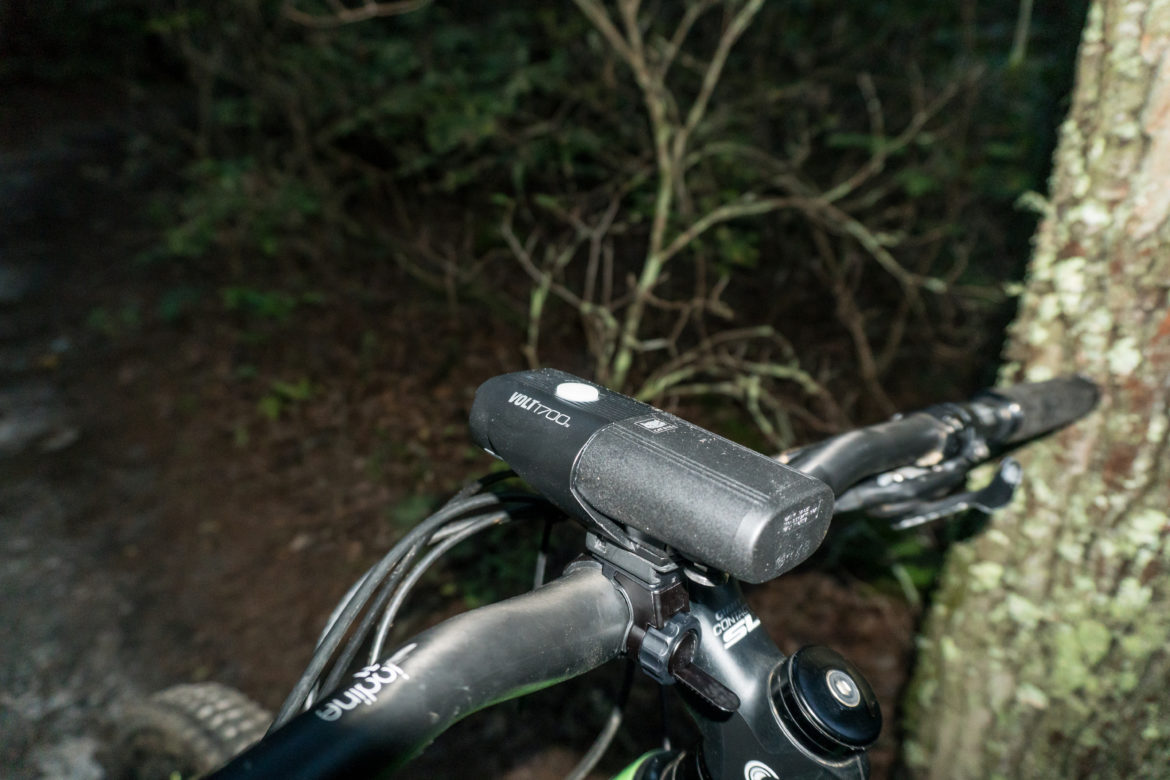
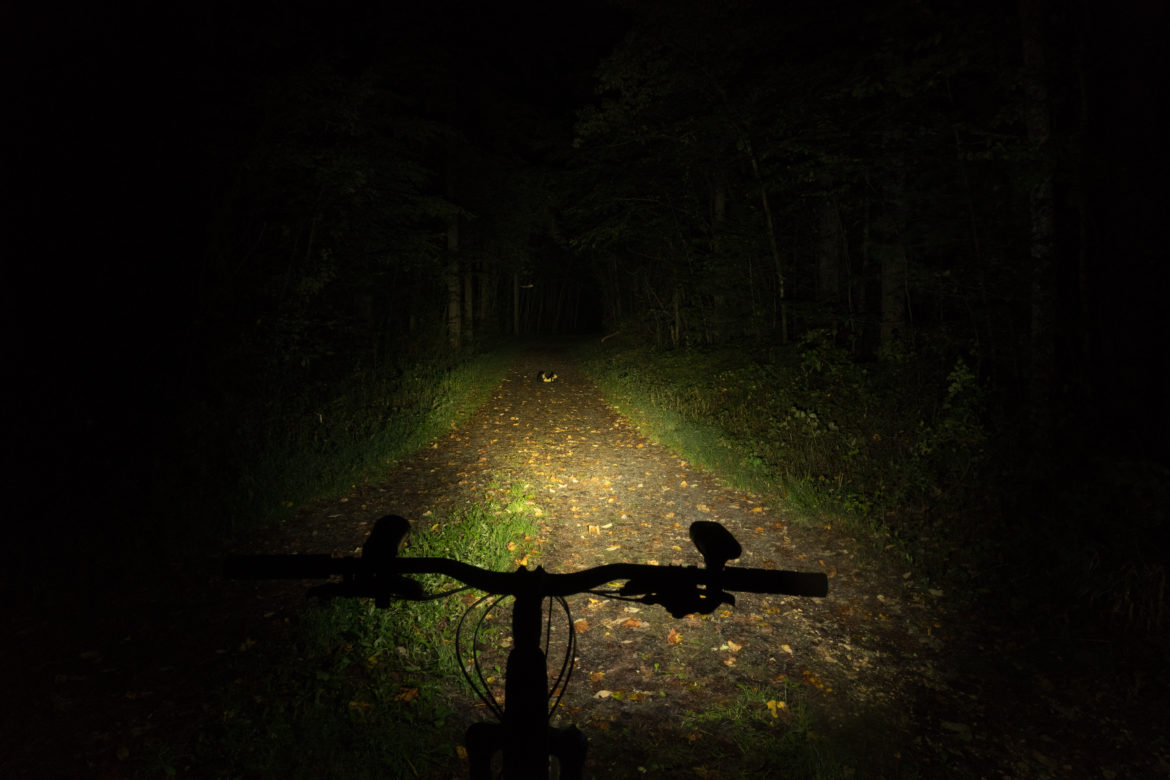
The Cateye Volt 1700 is $60 more than the Countdown but $30 less than the Taz. It’s the heaviest of the three all-in-ones, and the runtime is the longest at two hours on high. Like the Countdown, it features a tool-less mount that attaches to your handlebar, and then the light attaches to the mount via a secure quick-release mechanism.
It’s worth noting that the other two competitors advertise their lights as IP67 waterproof, meaning they can be submerged to a depth of one meter for 30 minutes. The Volt 1700 is described only as “All weather.” This shortcoming is probably because the battery can be removed from the light head with a quick release.
But thanks to this feature, you can bring along an extra battery on longer rides, or swap out as needed during one of those supposedly-fun, overnight endurance events. A spare battery will run you around $90, which is significantly less than a second light. MSRP $240.
Battery pack bike lights

While you can’t beat the convenience of the all-in-one models, if you’re going to go big (and bright) you’ll be looking at the lights in this category. Separating the light head and the battery pack gives designers a lot more versatility, and it allows riders to a mount small light head on a helmet that offers both power and runtime since the heavy batteries can be strapped low on frames or placed in a pack.
Some of these lights are even brighter than high beams on a vehicle, but it’s still a good idea to pair with a second helmet or bar light. You’ll be able to see what’s ahead even when your handlebars aren’t necessarily pointing there, and as an added bonus you’re statistically less likely to get stranded in the dark.
Gloworm XS 2500 and X2 1700
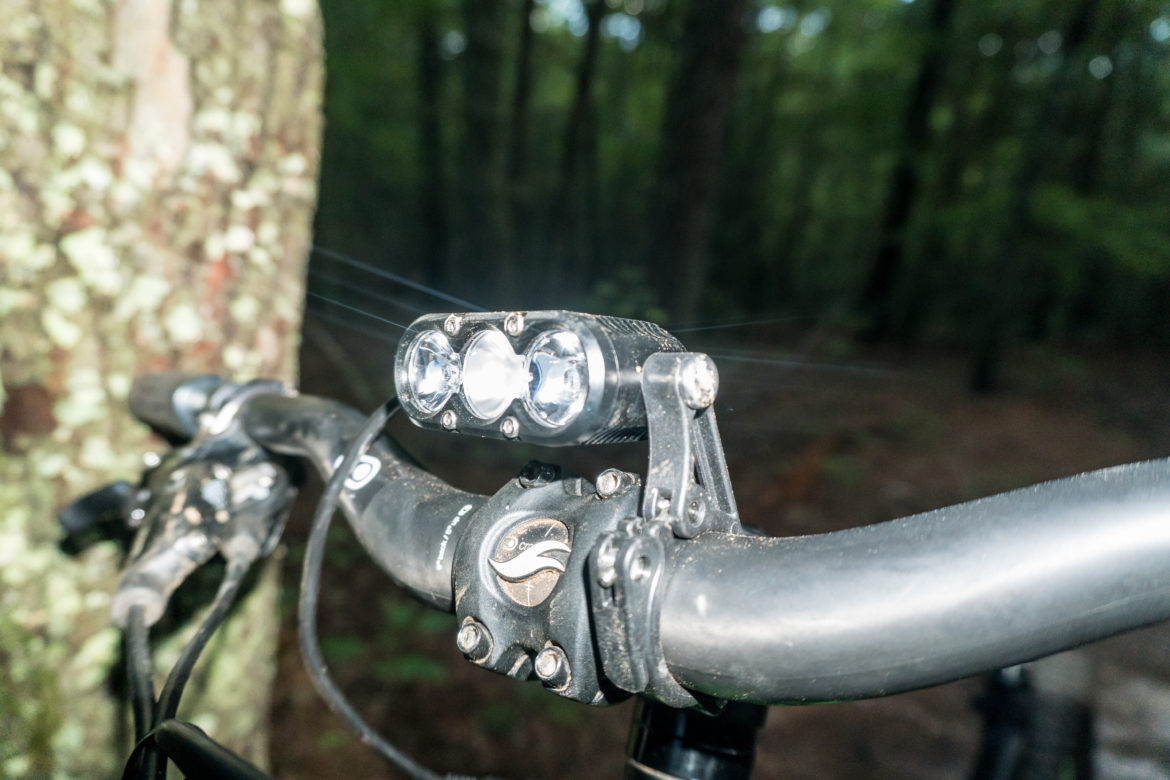



Gloworm lights use Cree LEDs mounted side-by-side. The XS 2500 housing has three bulbs while the X2 has a pair. Both ship with a variety of mounting options. A quick release can screw into the side of the light and clamp around the handlebars, or a GoPro mount can be used on a helmet.
Both lights include a 4-cell battery. The XS 2500 promises two hours on the brightest 2500-lumen setting and 36 hours at the lowest 200-lumen setting. The 1700-lumen output of the X2 will last three hours on high or up to five days at 100 lumens (I didn’t try leaving it on for five days).
All Gloworm lights ship with four specific levels of brightness, but thanks to Intelligent Mode Technology (IMT) these settings are completely customizable using these steps. The XS and XS also include a 2-button wireless remote. Assuming you have two lights, you can control both of them simultaneously with the same button or operate them independently using both buttons on a single remote.
Gemini Titan 4000


The Titan 4000 is a hell of a light. Six Cree LED bulbs sit in the aluminum housing side by side, which mounts right in the middle of the handlebars. The wide “stance” of the light and the rubber ring on either side of the stem means that it doesn’t budge once it’s aimed at the trail. This smart design looks good, and the symmetry struck a chord with me right off the bat.
The Titan comes with either a 6- or 8-cell battery, and Gemini didn’t skimp here. One winning feature about these batteries is the pouch they come in, which has a built in Velcro strap that makes it easy to attach to a frame (and hard to lose). With the 8-cell battery, the total weight comes to 600 grams: a 450-gram battery plus the 150-gram light head.
In return for lugging around that weight, mountain bikers get the power to ride pretty much all night, with a 2:45 runtime on high and as much as 23:20 on the lowest setting. The light is programmable, so buyers can adjust what Low, Medium, and High mean with 10 different settings. To make changing between settings easy on technical trails, the Titan 4000 comes with a wireless remote. Throw in an 8”x8” travel case that can fit an additional helmet light if you take out the foam, and you’ve got pretty much everything you need. MSRP $350.
Magicshine Monteer 6500


Magicshine’s newly released Monteer 6500 is a beast of a light. I’ve historically taken lumen claims from this company with a healthy grain of salt, but the Monteer may very well be 6500 lumens. Besides being insanely bright, the light comes with a quick-release handlebar mount that uses the same insert-and-turn system as some Garmin devices. It was the only mount that required a Hex key to attach, but once you put in on it won’t budge no matter how rough the trails get.
The Monteer has five LEDs, and three provide a flood light while the other two throw a spotlight further down the trail. You can choose to run the light in spot mode, flood mode, or both, and each setting has four different brightness levels. With all five LEDs burning on high, you’ll see everything in front of you for up to an hour and a half. On the lowest setting, you’ll get 650 lumens of output and a runtime approaching 15 hours. MSRP $350.
Cateye Volt 6000


Cateye’s Volt 6000 is a technological marvel, squeezing 6000 lumens out of a single, powerful LED. The light is crazy bright with a wide beam that easily encompasses everything in front of you, but to me the most exotic feature is the built-in cooling fan. On hot summer nights, many of the lights in this test easily get hot enough to burn skin if left on high while just standing around. The Volt 6000 remained at a reasonable temperature through it all.
The fan hums along fast enough to slightly vibrate the handlebars, which was sort of cool and made me feel like I was riding a dirt bike. It probably doesn’t help battery life, however. In Dynamic mode (full 6000 lumens), the Volt 6000 will only last an hour, although All-Night mode will put out 500 lumens for a casual 12 hours of riding. The fan is also a weakness in terms of weather resistance, and while the light stood up to a quick downpour as I was photographing the beam patterns, its internals are much more exposed than some of the other light models. Ultimately, the biggest downside of the Volt 6000 is the price. It retails for $799.99, which is more than twice as much as the next priciest light in the test. MSRP $800.
Superlatives
At the end of the day, you can’t really go wrong with any of these lights. That being said, each one has unique strengths that make it ideal for specific uses.
The Taz 2000 is perfect for commuters with its yellow side lights. The rock solid and super simple attachment system was also the easiest to put on and take off by far, making it very convenient for use with multiple bikes.
The Countdown 1600 is perfect if you don’t want to wonder how much battery life you have left. The timer is a fantastic feature that I would love to see integrated on more lights and batteries in the future.
The Volt 1700 is ideal for an all-night race where you’re doing laps or can send spare batteries ahead to aid stations. Swapping in a fresh battery is easy with the quick-release mechanism, and it saves you from having to buy multiple lights.
The Gloworm XS has a great power to weight ratio. It’s not as insanely bright as the three heaviest hitters in the test, but it comes in a package that’s significantly lighter, and it’s also tough enough to take a beating (or drowning).
The Gloworm X2 is an ideal helmet light. The GoPro mount holds it securely and means you don’t have to fuss with straps and Velcro, and at 89 grams you’ll forget it’s on your noggin until you accidentally beam 1700 lumens in your friend’s face. The runtime is also top notch.
The Titan 4000 doesn’t force buyers to choose between brightness and battery life. Get the 8-cell battery and have both, you greedy SOB.
The Volt 6000 is perfect if your shuttle vehicle is a Porsche. Kidding. Get this beast if night riding is life and you want a super wide beam angle that makes it impossible for sneaky bears to jump out at you from the side of the trail.
The Monteer 6500 is your light if you have Volt 6000 ambitions but you also want to put your kids through college. It has a fantastic beam pattern that illuminates even further down the trail than its more expensive rival, making it a light that’s impossible for Richie Rude to outride.


If you’ve never gone riding at night, I encourage you to give it a try. It’s a really cool experience being way out in the woods in the dark, and riding with a light gives you tunnel vision that zeroes in your focus on the trail in front of you. I guarantee night riding will teach you something that you didn’t already know about your local trails, no matter how many times you’ve ridden them during the day. But hey, you don’t have to take my word for it. Check out these 10 Reasons to Mountain Bike in the Dark.
If your only night riding experience involved a cheap light, you might want to consider an upgrade. Getting any one of these lights will transform your ride.
If you have questions about a light I tested, or think there’s something I didn’t address, don’t hesitate to leave a comment below.
Thanks to all the companies mentioned for providing these lights for testing. It’s been fun!











